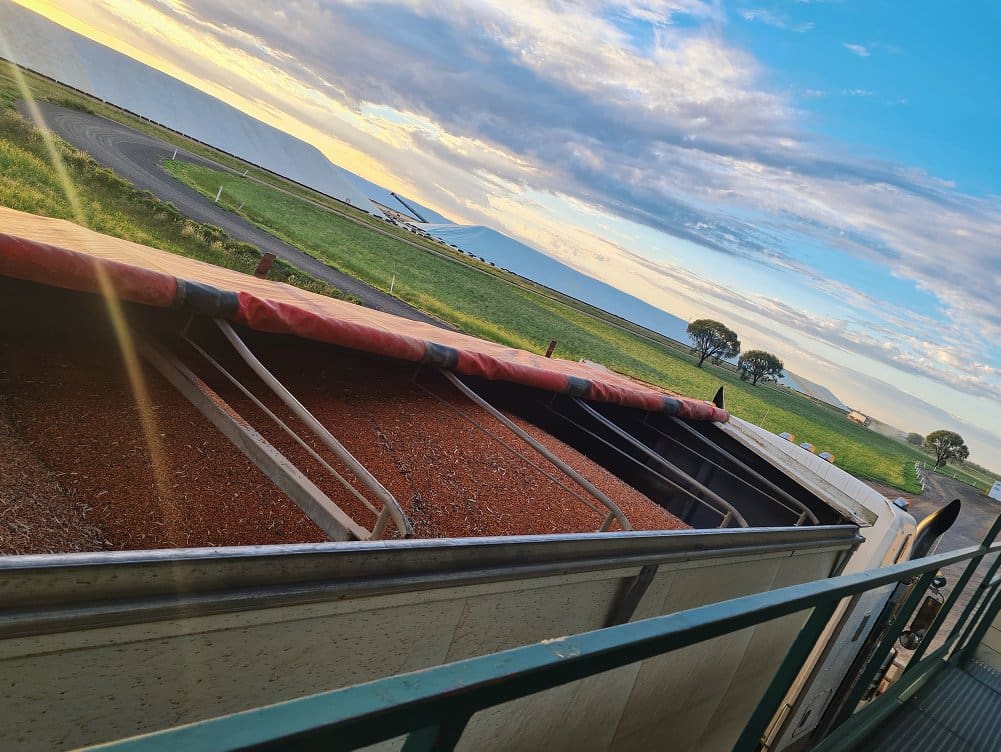
The first delivery of sorghum from this harvest arrives at CHS Broadbent’s Moree depot. Photo: CHS Broadbent
PRICE movements for feedgrains in eastern Australia were modest this week as the export market remains preoccupied with execution for nearby shipment, and domestic consumers hold off buying in the hope of a price softening.
Fuelling their hopes in the south is the strong and early run on growers buying inputs for the upcoming winter crop plant, often as the backload on a grain delivery.
In the north, growers continue to push barley and off-spec wheat into the market as they make way for a big sorghum crop which for most growers is getting bigger with the benefit of late rain.
| Today | Jan 27 | |
| Barley Downs | $290 | $290 |
| SFW wheat Downs | $310 | $305 |
| Sorghum Downs | $292 | $295 |
| Barley Melbourne | $318 | $315 |
| ASW wheat Melbourne | $375 | $380 |
| SFW wheat Melbourne | $340 | $345 |
Table 1: Indicative delivered prices in Australian dollars per tonne.
Rains slows sorghum harvest
Patchy rain in the past week has delayed the start in earnest of the southern Queensland and northern New South Wales sorghum harvest.
Sorghum straight off the header is going direct to container packers ahead of the bulk shipment program which is expected to start of Brisbane next month.
With sorghum at around $20/t under feed wheat, and nothing like the usual spread of $60/t, domestic interest in it is coming only from niche markets such as poultry breeders.
Early indications are for sorghum yields above expectations, with most crops romping in a healthy 5t per hectare or more.
Patchy storms and showers fell in pockets of the Queensland grainbelt in the week to 9am today, with Emerald recording 30 millimetres, ideal for just-planting sorghum crops, Dalby 8mm, and Roma 32mm.
In NSW, rain was also very patchy, with most locations having a dry week.
Locations with significant rainfall included: Condobolin 27mm; Griffith 31mm; Moree 34mm, and Gunnedah 16mm.
Showery weather has continued into today, mostly from Moree north, and has stopped some growers who have just started harvesting.
Robinson Grain Toowoomba-based trader Anthony Furse said early indications are that the sorghum crop now being harvested is of exceptional quality following good rain and mild temperatures.
“Screenings are low and test weights are good; there’s lots of 80kg (per hectolitre) around, when 75-76kg is normal and the minimum is 72kg,” Mr Furse said.
“Where yields were expected at around 5t/ha, some results are more like 6-7t/ha.
“The crop’s only getting bigger.”
Mr Furse said demand for wheat and barley from consumers has been subdued in the past week.
“I think there’s a lot of feedlot demand to come to market, and rightly so, because the beef sector has had quite a few disruptions with COVID affecting production.”
Now that the beef supply chain looks to be returning to normal, Mr Furse said feedlots are likely to step up their buying of barley and SFW wheat.
“There’s still barley out there, but SFW is not easily making its way into Queensland.”
This is because trucks carting grain north across the border to up-country sites do not have backloads of fertiliser or other inputs to help fund the exercise.
South busy with execution
Victoria and South Australia look likely to get off to an early and flying start on their winter-cropping program following widespread rain over the past fortnight in most districts.
It means growers are making an early run on fertiliser ahead of the planting window opening in April, and are mostly delivering grain, pulses or canola sold earlier ahead of the backload.
Rainfall in the week to 9am today has been patchy, with 42mm at Horsham AWS, 39mm at Annuello and St Arnaud, and 48mm at Ultima among the higher registrations in Victoria.
Most of SA’s cropping regions had a dry week to allow the deluge from the previous to soak in or run off.
Exceptions were Winter Springs on 31mm, Darke Peak with 24mm and Paruna on 15mm.
Melaluka Trading director Michael Fitzgerald said the southern market was fairly flat as the trade focussed on execution.
“Ports are active, and there’s plenty of grain going into Melbourne, Geelong and Portland, but in terms of the market, it’s flatlining.”
Mr Fitzgerald said the spread between ASW and SFW has narrowed a little, largely because ASW prices have softened.
“Milling wheats are off on the back of Chicago, but there’s still a premium for protein wheat, and there was a lot of that in the Mallee.”
He said barley had firmed, largely in response to demand for export grain ex Port Adelaide.
“The SA buyers are sweeping into Victoria, into the west Wimmera and northern Mallee, and it’s all priced back to Adelaide.”
Trade sources said the growing demand for SFW wheat for export could bring the domestic consumer to market for volume in the near term.
“SFW is exportable now; it’s going out in boxes and will start going out in bulk.
“There’s probably enough supply of wheat into the southern zone from trucks picking up fertiliser and lime, and once growers have got that and they’re sitting on their tractors, there might be a supply squeeze.”



HAVE YOUR SAY